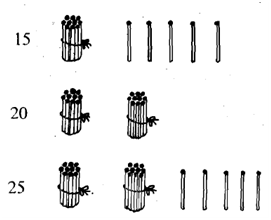I had just come back from a very interesting talk arranged by a Mathematics Centre, it was aimed at parents of primary school-going children. They had talked about, and demonstrated, various methods for enhancing the understanding of place value. I thought of trying out what was discussed and 7- year-old Alina, my neighbour's daughter, gave me an opportunity to do so. She wanted me to help her with some sums. I asked her if she was willing to do it my way, which she agreed to, with sode hesitation. So, 1 asked her to help me add 15, 25 and 10. She said, "Let me write it down." Then she proceeded to do it as in Fig. 4. 1 asked her to tell me how she got that answer. She said "First I added the numbers in the ones place, 5 + 0 + 5 = 10, and wrote it down. Then 1 added the numbers in the tens column, which is 4. So the answer is 410." I didn't make any negative comments, but 1 did the following activity with her.
I gave her a heap of matchsticks, and asked her to make some balrdles of ten matchsticks each from the heap. Then I asked her to give me 5 matchsticks, which she did. When I asked her for 10 sticks, she counted them out and gave them to me. Gradually she was able to understand that giving one bundle meant giving 10 sticks, and that whenever we have 10 sticks we could made a bundle with them. Soon, for any number asked, she gave the required number of sticks and bundles :

1 asked her, "How much do you get when you add up all these bundles and sticks ?" She counted all her bundles and sticks, and said, "45".
Next, I asked her to give me 35 sticks. She gave me 3 bundles and 5 sticks. Then I asked her to give me 60 sticks. She pondered for a moment, and then gave me six bundles.
Then I asked her to play a game with me. I also called her older sister, and John. We sat down in a ring after collecting a lot of stones, a dice, about 20 cards and 10 coloured beads. I said each of us would have a piece of paper on which we would keep a record of how the game proceeds. The record consisted of 3 columns: one for the stones, one for the cards and one for the beads.
The game is played as follows:
Each player throws the dice by turn, and picks up as many stones from the ground as the number shown on the dice. Then the person writes down the number of stones in the stones column: When her turn comes round again, she throws the dice and picks up as many stones as the number that the dice shows this time. If the number of stones with her becomes more than 10, she has to put 10 stones back into the main pile and pick up one card instead. Whenever it happens the person should alter her record, to write the number of cards and stones available with her now. Whosoever gets 5 cards first wins the game.
All of us enjoyed the game. After we had played it 3 or 4 times, and everybody except me had managed to win, I proposed that we extend the game. In the extended game, we could collect 10 or more cards. And anyone getting 10 cards, would have to put all of them in the middle and pick up a bead instead. Whoever got 3 beads first would win.
This game became very long drawn out, and nobody seemed to be winning. Suddenly John said, "It will take a lot of time because each bead needs 10 cards and each card needs 10 stones. That means each bead needs 100 stones." I said, "Well we could play this game with two dice together and decide the winner." When we played with two dice the elder sister and I had to often help the youngsters fill up their chart. And soon, they tired of it.